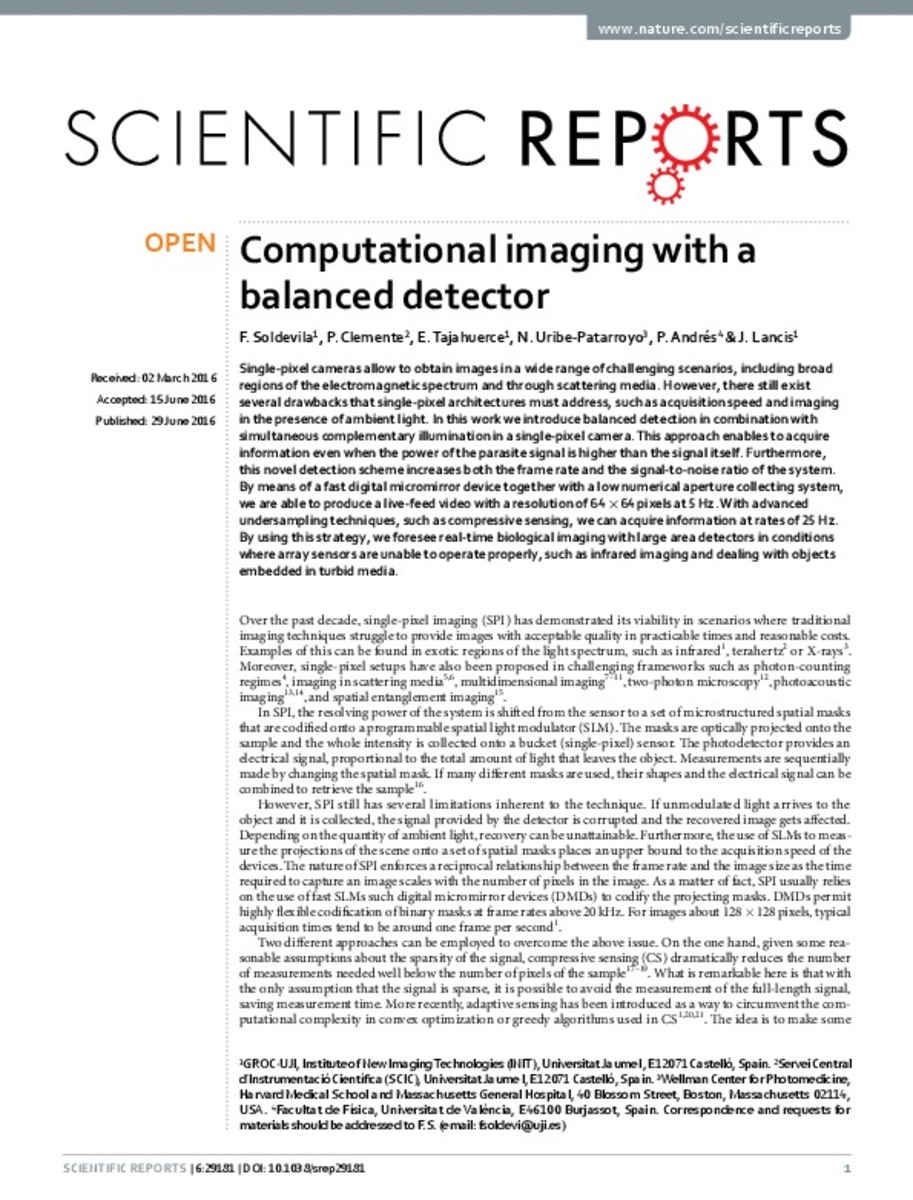Mostrar el registro sencillo del ítem
Computational imaging with a balanced detector
| dc.contributor.author | Soldevila, Fernando | |
| dc.contributor.author | Clemente Pesudo, Pedro Javier | |
| dc.contributor.author | Tajahuerce, Enrique | |
| dc.contributor.author | Uribe-Patarroyo, N. | |
| dc.contributor.author | Andrés, Pedro | |
| dc.contributor.author | Lancis, Jesús | |
| dc.date.accessioned | 2016-07-08T10:21:44Z | |
| dc.date.available | 2016-07-08T10:21:44Z | |
| dc.date.issued | 2016-06-29 | |
| dc.identifier.citation | SOLDEVILA, F., et al. Computational imaging with a balanced detector. Scientific Reports, 2016, vol. 6, p. 29181 | ca_CA |
| dc.identifier.issn | 2045-2322 | |
| dc.identifier.uri | http://hdl.handle.net/10234/161554 | |
| dc.description.abstract | Single-pixel cameras allow to obtain images in a wide range of challenging scenarios, including broad regions of the electromagnetic spectrum and through scattering media. However, there still exist several drawbacks that single-pixel architectures must address, such as acquisition speed and imaging in the presence of ambient light. In this work we introduce balanced detection in combination with simultaneous complementary illumination in a single-pixel camera. This approach enables to acquire information even when the power of the parasite signal is higher than the signal itself. Furthermore, this novel detection scheme increases both the frame rate and the signal-to-noise ratio of the system. By means of a fast digital micromirror device together with a low numerical aperture collecting system, we are able to produce a live-feed video with a resolution of 64 × 64 pixels at 5 Hz. With advanced undersampling techniques, such as compressive sensing, we can acquire information at rates of 25 Hz. By using this strategy, we foresee real-time biological imaging with large area detectors in conditions where array sensors are unable to operate properly, such as infrared imaging and dealing with objects embedded in turbid media. | ca_CA |
| dc.description.sponsorShip | This work was supported by MINECO through project FIS2013-40666-P, and Generalitat Valenciana projects PROMETEO/2012/021 and ISIC/2012/013. Also financial support by Universitat Jaume I (project P1-1B2012-55) is acknowledged. F.S. was supported by Universitat Jaume I (PREDOC/2013/32). N.U.-P. acknowledges partial support from the National Institutes of Health (P41EB015903). | ca_CA |
| dc.format.extent | 10 p. | ca_CA |
| dc.format.mimetype | application/pdf | ca_CA |
| dc.language.iso | eng | ca_CA |
| dc.publisher | Nature Publishing | ca_CA |
| dc.relation.isPartOf | Scientific Reports, 2016, vol. 6 | ca_CA |
| dc.rights | This work is licensed under a Creative Commons Attribution 4.0 International License. The images or other third party material in this article are included in the article’s Creative Commons license, unless indicated otherwise in the credit line; if the material is not included under the Creative Commons license, users will need to obtain permission from the license holder to reproduce the material. To view a copy of this license, visit http://creativecommons.org/licenses/by/4.0/ | ca_CA |
| dc.rights.uri | http://rightsstatements.org/vocab/InC/1.0/ | * |
| dc.title | Computational imaging with a balanced detector | ca_CA |
| dc.type | info:eu-repo/semantics/article | ca_CA |
| dc.identifier.doi | http://dx.doi.org/10.1038/srep29181 | |
| dc.rights.accessRights | info:eu-repo/semantics/openAccess | ca_CA |
| dc.relation.publisherVersion | http://www.nature.com/articles/srep29181 | ca_CA |
| dc.type.version | info:eu-repo/semantics/publishedVersion | ca_CA |
Ficheros en el ítem
Este ítem aparece en la(s) siguiente(s) colección(ones)
-
INIT_Articles [743]







